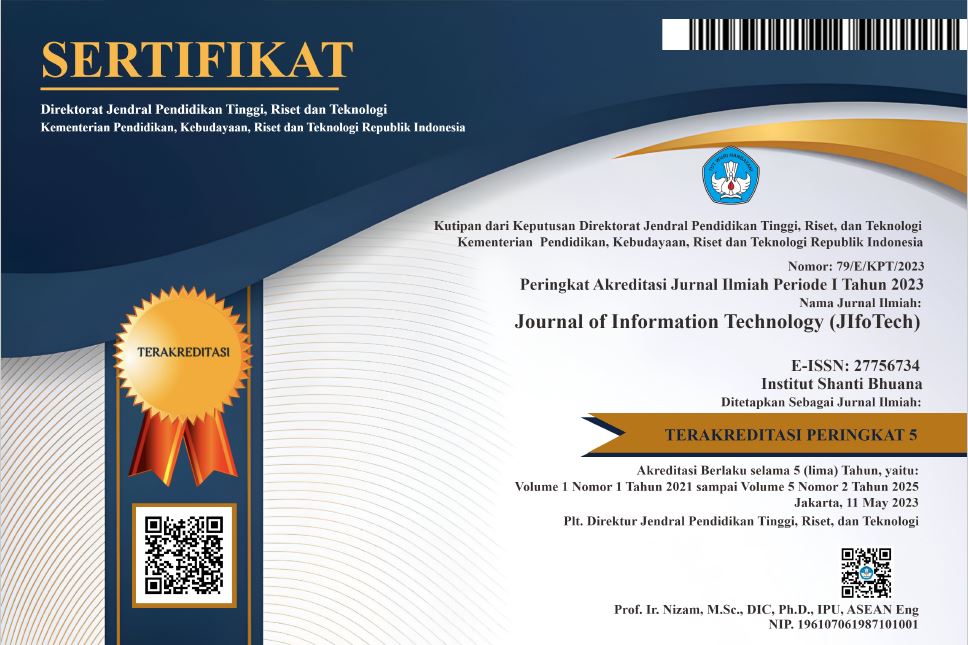Classification of Image Files of Lung X-Ray Results with Architecture Convolution Neural Network (CNN)
Abstract
In the last decade, the use of artificial intelligence (AI) is increasing, Convolution Neural Network (CNN) architecture as one of them has helped the world to process Big Data (big data), by conducting a training process from a large number of image datasets, and then being able to learn its characteristics and then select according to its classification. The use of the python programming language as a means to classify an image file with CNN architecture is very good and has very high accuracy. Keras is a module that has been prepared by python programming language developers to support self-learning artificial intelligence that also supports CNN architecture. In CNN programming with python language, it is mentioned that the more parameters are tested, the better the artificial intelligence gives output. Therefore, the objective this test is to prove whether the more parameters given to the system can provide better output with the method used is to provide input dataset training. The results of the study can be from the number of parameters learned 1,059,106 with an average time of 135 ms, then the machine can classify the image correctly by 87.88%. if the machine learns with more parameters of 3,824,486 with an average time of 780 ms, then the machine can guess close to 100%. The results of the study can be seen that the more the machine learns with its artificial intelligence capabilities, the more proficient the machine will be.
References
N. Van Hieu and N. L. H. Hien, “Recognition of plant species using deep convolutional feature extraction,” Int. J. Emerg. Technol., vol. 11, no. 3, pp. 904–910, 2020.
A. S. B. Karno, W. Hastomo, & Arif, D., and E. S. Moreta, “Optimasi Portofolio Dan Prediksi Cryptocurrency Menggunakan Deep Learning Dalam Bahasa Python,” vol. 4, no. September, 2020.
W. Hastomo and A. Satyo, “Long Short Term Memory Machine Learning Untuk Memprediksi Akurasi Nilai Tukar IDR Terhadap USD,” Proseding SenTIK, vol. 3, 2019.
I. Bakti and M. Firdaus, “Arsitektur CNN InceptionResNet-V2 Untuk Pengelompokan Pneumonia Chest X-Ray,” J. Komput. dan Teknol., vol. 1, no. 2, pp. 35–42, Jan. 2023, doi: 10.58290/jukomtek.v1i2.66.
W. Hastomo, A. Satyo, B. Karno, and N. Kalbuana, Indra Bakti: Klasifikasi File Gambar Hasil (…) P-ISSN 2774-4884 | E-ISSN 2775-6734 “Characteristic Parameters of Epoch Deep Learning to Predict Covid-19 Data in Indonesia,” J. Phys. Conf. Ser., 2021, doi: 10.1088/1742-6596/1933/1/012050.
W. Hastomo and A. Satyo, “Kemampuan Long Short Term Memory Machine,” vol. 4, no. September, pp. 229–236, 2020.
L. M. R. Rere, R. Dalam, and K. Baru, “Studi Pengenalan Ekspresi Wajah Berbasis Convolutional Neural Network,” vol. 3, 2019.
L. Alzubaidi et al., Review of Deep Learning Concepts, CNN Architectures, Challenges, Applications, Future Directions, vol. 08, no. 01. Springer International Publishing, 2021.
B. Prijono, “Student Notes: Convolutional Neural Networks (CNN) Introduction,” Indo Machine Learning, 2018. .
Sebastian Raschka, “Activation Functions for Artificial Neural Networks,” github.io, 2020. .
A. S. B. Karno and W. Hastomo, “Optimalisasi Data Terbatas Prediksi Jangka Panjang Covid-19 Dengan Kombinasi Lstm Dan GRU,” SeNTIK, vol. 04, no. September, pp. 181–191, 2020.
S. Bianco, R. Cadene, L. Celona, and P. Napoletano, “Benchmark analysis of Representative Deep Neural Network Architectures,” IEEE Access, vol. 06, pp. 64270–64277, 2018, doi: 10.1109/ACCESS.2018.2877890.
M. Sandler, A. Howard, M. Zhu, A. Zhmoginov, and L. C. Chen, “MobileNetV2: Inverted Residuals and Linear Bottlenecks,” Proc. IEEE Comput. Soc. Conf. Comput. Vis. Pattern Recognit., pp. 4510–4520, 2018, doi: 10.1109/CVPR.2018.00474.
“COVID-19 Patients Lungs X Ray Images 10000,” kaggle, 2020. https://www.kaggle.com/datasets/nabeelsajid917/covid-19-x-ray-10000-images.
Copyright (c) 2023 Indra Bakti, Mohamad Firdaus

This work is licensed under a Creative Commons Attribution 4.0 International License.






















